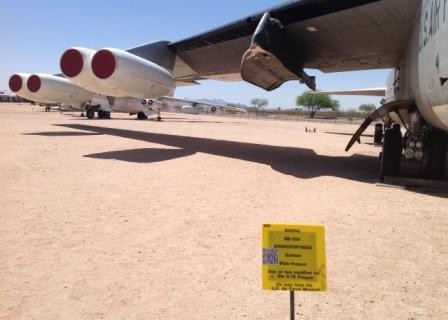Let me quote from the Wikipedia:
“The Smithsonian Institution was founded for the “increase and diffusion of knowledge” from a bequest to the United States by the British scientist James Smithson (1765–1829), who never visited the new nation. In Smithson’s will, he stated that should his nephew, Henry James Hungerford, die without heirs, the Smithson estate would go to the government of the United States to create an “Establishment for the increase & diffusion of Knowledge among men”.
“The Smithsonian Institution is the largest museum complex in the world, and many of its buildings are historical and architectural landmarks.”
During our last trip to USA, Luca and I visited both locations of the National Air & Space Museum of the Smithsonian institution. I had already been at the one in the Mall and I already talked about it briefly in a previous post. I wanted to write about the museum at Dulles, close to DC international airport.
That museum is named after Steven F. Udvar Hazy, who is the CEO of Air Lease Corp, an airplanes leasing company. Previously he was chairman and CEO of ILFC, another leasing company, together with GECAS, one of the 2 biggest. The guy is a living legend or commercial markets: when he blessed or criticizes an aircraft it is seriously noticed by the manufacturers. He donated 65M$ to the Smithsonian to set up this museum and that’s why it carries his name. Thanks Steve! What a museum! The NASM is awesome!
The museum has dozens if not over a hundred of airplanes, satellites, rockets, helicopters, etc., in display, all tagged with small explanation of the aircraft.
On our visit we joined a free guided tour, another fabulous feature of the museum. Our guide was Bill Laux, a veteran pilot from the Navy. He was originally from Omaha where we would be going in a couple of days while he would be heading also in a couple of days to Belgium… crossing roads.
We stayed with Bill for about 2 hours, following one explanation after the other, one curiosity here, another detail there, etc. I remember visiting Ellis Island in NYC 2 years ago with a ranger who also filled the tour with stories. This is something I really like: instead of paying for a quick tour or audio-guide, they make use of the willingness of these volunteers to pass on their knowledge.
I have to admit that the session was for core aviation geeks, and I want to commend Luca for standing it. At the beginning we were a group of 10-12 people, wives and children included. The guide asked: “Who has got an aerospace background?” 4 or so of us raised hands… after 30 minutes of tour only Luca and those with aviation background continued with the tour (no sight of wives and children). After 1 hour 30 minutes, only Luca and me. After 2 hours the guide went “well, we’ve seen pretty much everything” :-). Thanks Bill!
I scanned one of the sides of the map of the museum to post it here. The map covers the Boeing hangar, but bear in mind that there is another hangar missing (James S McDonnell, which hosts a Space Shuttle), an IMAX cinema, the restoration hangar and the control tower.
I wanted to post it here so you can get a grasp of what we’re talking about. Airplanes packed side by side, one of top of the other… and not any airplane, some are unique pieces. Let me just comment on a few of them (of which below you can find the pictures):
- The Space shuttle Enterprise: which never went to outer space as it was used only for training purposes, to let astronauts command the powerless flight after re-entry. Believe it or not, it was going to be named “Constitution”, trekkies had not stepped in.
- A Lockheed SR-71A Blackbird: the reconnaissance aircraft which set the record as fastest aircraft back in 1976.
- The Boeing 367-80 “Dash-80”, which as I already mentioned in a previous post, was the prototype Boeing built to test and market a new configuration for commercial jet aircraft, a configuration which all commercial aircraft have followed more or less ever since.
- A Concorde.
- The famous B-29 Enola Gay.
- The Langley Aerodrome A: a model that Samuel Pierpont Langley (a manned flight pioneer and secretary of the Smithsonian institution at the time) used to try to set the first heavier-than-air flight… he didn’t, as the model crashed in the Potomac river.
- A Junkers 52 built by the Spanish CASA.
- A Boeing 307 Stratoliner: the first pressurized commercial aircraft.
This slideshow requires JavaScript.
I would only give one point of improvement for the museum: now you cannot get into the aircraft except for simulators, if they would just change that policy it would be just perfect (in the Mall you can actually enter in some models, e.g. Spacelab).
I forgot to mention some extras: the museum is free (free as in zero dollars), it has a transport leaving every hour to and from Dulles airport which costs just 50 cents, has lockers for big luggage free of charge, has a nice souvenir shop with plenty of aviation books and even a McDonald’s to recover some strength at half way of the visit…
In future posts I will comment some of the details of some aircraft… give credit to Bill, our guide.













